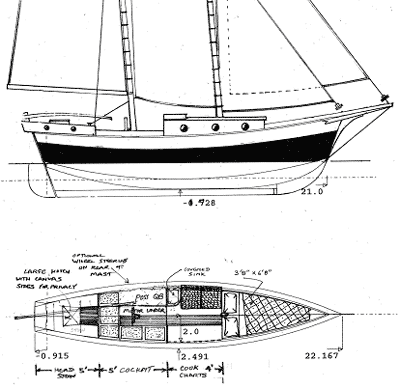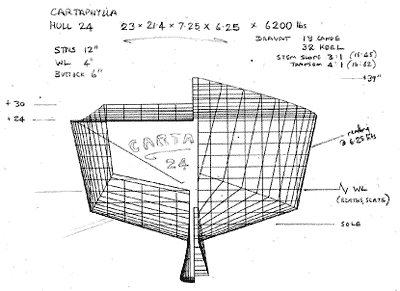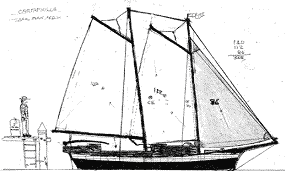The hull was always intended to embody the East
Coast tradition of the fast rakish trading schooner, but it
had to be both affordable and ocean going, two aims so at odds
that I thought the whole business worth forgetting. But the
idea would not go away, and I became heartened about the cost
of such a design if the compromises others had used could be
combined within a strong simple plywood hull. A few light schooners
for sheltered water use had been successfully turned out, and
I noticed Garden’s little 20ft schooner-rigged flat-bottomed
double-ender Sandpiper, which was so simple the prototype was
built by a schoolboy. It seemed all that was needed was to add
a strake, turning the flat bottom into a swell-carving vee.
I thought of the elegant simplicity of the loose-footed gaff
rigs of Wharram’s catamarans, including those in the Schooner
rig of his own Gaia, rigs which safely bring the centre of effort
low, raising stability and exponentially lowering costs in one
fell swoop. I revisited the Aussie “Flying Tadpole”
Bolger Light Schooner website, and felt that a stronger, stiffer
ballasted relative could be sealed against the elements and
make successful, albiet Spartan, passages.

Hence I decided to draw up such a boat and see
if there were folks like me who wanted a traditionally styled
wooden alternative to the parade of efficient but soulless plastic
sloops. Cartaphylla the Wandererer would be a solid pocket cruiser
using 3 sheets of plywood as its length – hence just two
butt joins/scarfs along a single chine hull 23 feet on deck.
I allowed just a foot of overhang each end, forrd to accommodate
the de rigeur clipper bow and aft to balance looks, and lighten
a largish rudder in order to assist self steering off the long
tracking keel.
She was to carry a traditional rig – this
suited admirably with its low centre of effort and possibly
winchless sail plan. The initial desire for a wonderfully slim
replica, almost plank on edge 5300lb hull with just 5 feet of
beam, produced interest aplenty, mostly screams from frustrated
would-be-voyagers who envisaged mildly useful accommodations,
and produced further trouble at the drawing board as she had
little sail carrying ability without heavy ballasting.
By this time I had decided the boat would be too
small and pretty to carry a tender, and hence would be amazingly
shoal of draught at 32 inches to achieve shore access sans dinghy,
& enable a beach bottom scrape between tides. A generous
lazarette could house an inflatable for the inevitable occasions
when one could not nose up to one of those idyllic grassy riverbanks
which apparently don’t exist outside of my drawings. (Even
the optimistically named Meadow Lark winds up at the Marina
with some would –be-Rockerfeller gleefully measuring her
bowsprit). This lazarette would add a poop deck element to the
style, & remove the dread bucket from the accoms. In correct
Naval Architectural terms this would be known as “dramatically
reducing the waft”.
So the boat grew in agonised stages from narrow
to slender to a final WLL:Beam of 3.5 to which the adjective
“slimmish” might precariously append. I added the
ultimate proviso that she should fit into a container. Downwind
cruises to the West Indies, followed by exploring the islands
and shipping home while you return to work would be viable.(Unless
like me your job is akin to sailing upwind into a Typhoon of
bullshit). In short the ability to ship the boat would be a
boon should one need to sell. Cartaphylla was to be her own
lifeboat too, super strong and 180 degree self-righting . Quite
a challenge on such shoal draught, but achieved in the end by
moderating midships flare while keeping the sidedecks narrow,
and using high coamings to reduce resultant spray. The cabin
top and lazarette “poop deck” are at a level, &
provide the vital righting moment between 150 and 180 degrees.
Cartaphylla was intended as a yacht for life,
a boat that was affordable, yet at 3 tons able to achieve the
load carrying, motion comfort and speed to take a pair of sufficiently
obsessed voyagers across oceans. A pocket cruiser which would
not only make a trip, but be a point of interest in strange
ports. A social icebreaker - everyone loves a schooner, particularly
a salty wooden gaffer with jutting bowsprit and a faraway port
wearing off its transom. (The gaffs & ‘sprit provide
spread more than show, & will enable this little ship to
carry more sail on a reach than one could with a tall Marconi
rig. One can stand on Cart’s cabin top and reach the centre
of effort, but as a result the length over spars is dangerously
close to 30 feet. Should this cause marina fee paranoia, a commensurately
infuriating folding bowsprit could be devised. I look forward
to designing it with all the enthusiasm of a man counting nails.)
To create an able comfortable cruiser it was decided
to make the accommodations unfussy, simple and extremely comfortable
for two, with a large aft lazarette to keep all that be wet
and smelly out of the main cabin area. Laz & cabin sides
are linked by a 9” coaming, thus corralling a large, safe
self draining central cockpit –a place to laze & enjoy
the view with more than the usual degree of safety. In port
here is room for a hammock, and a basic hundred dollar A-section
tent will reach from windscreen to poop providing privacy and
shelter as needed.

Cart in Feet: L0A 29.80, LOD 23.00, LWL
21.27, BOD 7.18, BWL 6.26, FREEBOARD 3.25, 2.00, 2.50, DISP
6200, BALLAST 32%, LCB 12.13, LCG 12.05 DRAUGHT 2.67, PRISMATIC
0.63
Cartaphylla’s major task is to make sea
miles on a waterline with a square root of just 4.6! However
if we settle for sitting headroom, Cart can sport minimal rocker
and a 6degree buttock run. So I’ve drawn a hull with strong
leanings towards semi-displacement, aiming for a S/L ratio of
just over 1.5 to give 7-knot capability. This is not to say
we can do 7 on every point of sail when we please, or ever do
it on any point of sail, merely that the hull will allow it
given stiff enough ballasting and the right wind and sea states.
A hull this short will never be lightning fast without planing,
but this one is designed to motor more efficiently than a full-bellied
full-displacement yacht of its length.
The way to make passage times is not to go bash
your boat bits at her limit, but to make sure she maintains
most of what speed she has, to maximise her low speeds. This
is where Cart is a winner, being the perfect size and weight
to take one of the smallest of diesels such as the Farymann
18w which can bowl her along 100nm in a seaway in 24 hours,
running at near peak torque on a comfortable 2/3 revs, and using
just 30 litres of diesel the whole day. Many of the popular
Trawler yachts guzzle that per hour, without going much faster.
So armed with the knowledge of these automotive-like fuel mileages
we know Cart. may cover 800nm with a 240 litre tank, & she
is designed to carry just that, and a lot more should you wish.
Losing an inch of freeboard can double this nominal fuel supply,
which could be expanded to encompass motoring the Atlantic with
the aid of a watermaker and a calculated safe initial level
of overload. Note that the watermaker should be used safely
– one must take off with a supply of water and make sufficient
water so you always have aboard twice what you need to get to
the nearest source at your normal daily run.
The engine space has been allocated in the rear
2.5 feet of cockpit. The correct sorts of motor will be able
to assist ballasting by bedding low enough in the hull to run
a shaft almost parallel to the waterline. If the budget runs
to a variable pitch prop, even more wonders are possible with
the chance to motor-sail in “overdrive”, adding
to your sail power and motor-sailing on a reach at 6 knots with
minimal heel. The designated space is large enough for the larger
12-18HP generation of motors for those who prefer to motor at
higher speeds while retaining good economy, and in the very
likely event that a diesel is off the budget for the time being,
there is space and hull area to perform bottom surgery and site
an outboard well in almost the same spot, the shaft being offset
to one side of the keel. Obviously the fuel efficiency will
not be as good, but it will still be very much on to motor Doldrums.
I believe the decision to bend Cartaphylla to the task of motor-sailing
is not detrimental to her pure sailing abilities, as she was
initially quite light. The additional weight of engine and fuel
is low in the hull and makes for a more comfortable motion.
Overly light pocket cruisers, like tiny cars, are exhausting
on a trip.
She was always at the light end of the cruising
diplacement/length ratio range for decent travelling yachts.
More weight cant hurt. The combination of hefty weight and lower
sail areas at sea has proven so effective that some of the better
stock designs offer a "cruising" package, eg Dehler,
while others go straight for it, long tracking keel and all
(Island Packet). The additional weight of engine and fuel is
low in the hull and makes for a more comfortable motion. Overly
light pocket cruisers, like tiny cars, are exhausting on a trip.
Cartaphylla aims to leave the dock for a fortnights cruise with
SA:Displacement of 16 and Displacement:WLL of 283, firmly in
the cruising comfort & safety zone. The idea that she carries
a massive sail plan is an illusion created by the sail spread
sans hoist, the opposite of the current fashion. One will of
course be attracted to the option of entangling oneself to the
gills in all kinds of Fisherman & other staysails with wonderful
names which are great until you try to put one up or down
quickly.
Gaff rigs don't point quite as high. She is shoal.
She needs bouyant ends (see next para.). Her Prismatic of 0.63
creates a lot of downwind speed with a little lost upwind. It's
a fact that she is not optimised for upwind sailing, it would
take an entire character change to make a difference. Far far
better to recognise that these same factors make her efficient
under power, install the economic engine she was designed for,
and motor-sail upwind at a really good clip. In trying to optimise
her upwind performance we would lose the lot. I'm talking relativity
here, I'm not saying she won't sail upwind, she will, but she
simply can't have a deep fin, and high aspect sloop rig. The
fact is that a lot more sailors would motorsail the slower points
if their boats were not abominably thirsty.Yours isn't, so set
up with a decent motor you can be there on time.
I was still faced with the problem of getting
a boat through the water with a sail plan that put much power
forrd. Essentially how to get the water past a hull which needed
the bow bulk/lift to carry a sprit and foremast without plunging,
After the usual merry-go-round of drawings and calcs I was satisfied
that the answer was in a goodly forefoot that cuts the seaway
low, eliminating bow slap without losing volume. Carts moderate
19-degree deadrise vee hull also grew judicious flare in the
fore sections, in keeping with the “cods head” look
of a typical schooner deck plan. Aside from the hydrostatics,
the hull looks well, always a good sign. Nothing comes for free,
but its been proven on much more radical designs that eased
fore keel will compensate for the larger forefoot in bringing
her head around on a tack.

Designers whose work I studied around and about
the years I spent conceiving and finetuning this little yacht
include Chapelle, Parker, Brewer, Beuehler, Garden, Bolger,
Herreshoff, Colvin, Crocker, Gustaffson, Bombigher and Devlin.
But though I pore over the lines and writings of these fine
Gentlemen at length, when I actually get to the drawing board
and computer all books have been firmly closed for some time
and stay that way until I have a hull. Thus not a line or idea
is directly scaled or copied. This I believe is the only way
to produce original work. Of course finetuning and comparison
is made later, but I at least am able to see that the work is
my own. One uses a conventional design spiral to finish the
job, but by this stage one usually has a boat sufficiently original
& firmed-up to hydrostatically resist attempts to shove
its looks toward another’s style. (I imagine this can
happen subconsciously). Insistence on originality backed by
extensive checks is time consuming, and may be why Cartaphylla’s
hull is version 24!
And so we have Cartaphylla, a boat whose profile and plan are
slightly reminiscent of the trad East coast schooner, too small
to imitate one, but bold enough to relate. She hides a cruising
tankage and a motor where the hold of her bigger relatives would
have been. A firmly stated forefoot and clean entry flow into
a 32 inch draught long ballasted keel leading a full rudder,
and her hard chine sections have moderate Vee with high form
stability complemented by ballast & completed to 180 degrees
by cabin and poop-deck-lazarette. Her sail plan is pure trad
gaff schooner, but simplified to a single jib on a furler.
Set up for a perfect safety record, she is designed
to carry two EL1000 one tonne Turtle-Pacs, which will keep her
afloat indefinitely even after a catastrophic hull breach. The
Pacs stow in their own self-opening bags and are fixed firmly
to the hull, inflating in 40 seconds from a standard scuba tank.
A single $478 Pac will prevent Cart foundering, but one at each
end of the boat means unsinkability even if one is damaged in
the debacle. Two inflated will ensure you can move about within
the cabin to radio for help from the set mounted high on the
chart table, and possibly seal the leak before pumping out.
This is entirely possible as the lazarette and main cabin are
sealable sections, whilst I’m looking into the possibility
of sectioning off the forepeak with a little live, scared effort.
There will also be a sealed locker for flares, EPIRB and another
GPS sealed in Ziploc bags. This wad of safeties cost less in
toto than an in-service liferaft, yet are more effective. They
convert Cartaphylla into an unsinkable lifeboat which would
be driveable under sail and even motor if you are lucky enough
to have one dry. Laszlo
Torok’s Turtlepacs provide an unshakeable
last line of defence against invisible semi-submerged containers,
and he invented them after many years of cruising.
Cartaphylla sports the motoring efficiency to
motor-sail passages considered timely for yachts twice her size,
by eliminating becalmed periods. Loaded for an Ocean Passage,
she can be trimmed along the way by some internal ballast along
with a honeycomb of boxes below the cockpit, which enable small
units of flexible tankage to be moved to one side for those
long passage tacks.
The process of designing her was so longwinded
that I felt I should document it in the interests of those who
do me the honour of building and sailing her. Hence this rather
lengthy narrative, which is partly myself ruling off the hull
design before I go on to the final sail plan and the thousand
details that will go into her furniture-integrated hull. This
will happen over the next few months and the first Cartaphylla
begins construction in Aug.2004 by Mr Dave Burdecki of San Francisco.
My thanks to him, Carl, Dmitri, & a special vote of thanks
to Terrell Guillory for his unbounded enthusiasm.
You guys are what this is all about, creating
something from nothing, and the sum of us can do what the parts
couldn’t. So thanks to all of you, and Chuck himself,
and the many people who put up their hand and proved to me that
people still have the guts & sense to go to sea in a beautiful
cantankerous little wooden ship they made.


